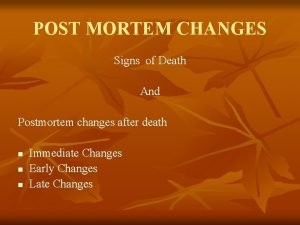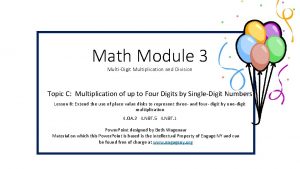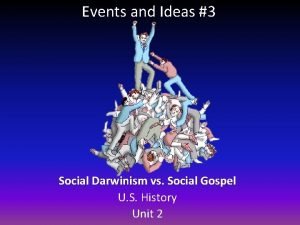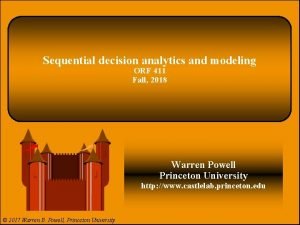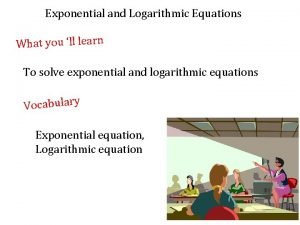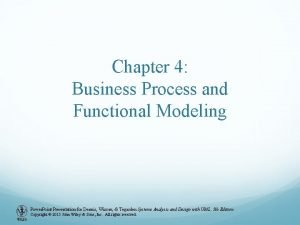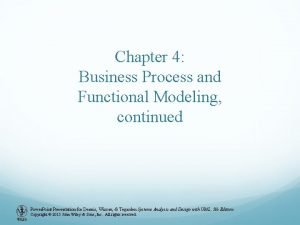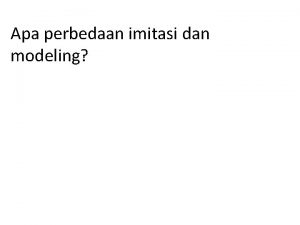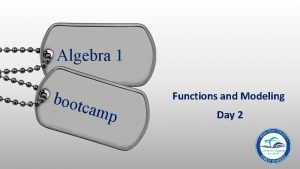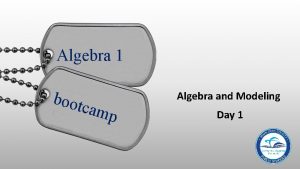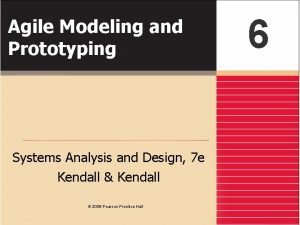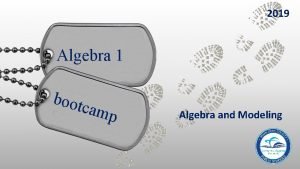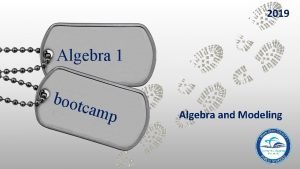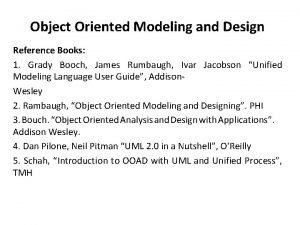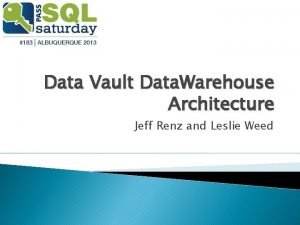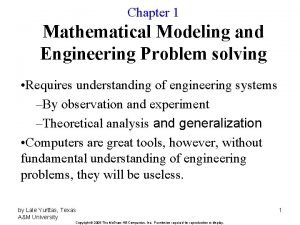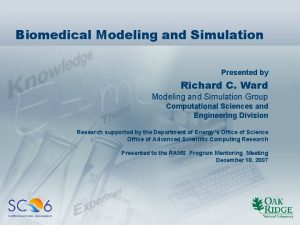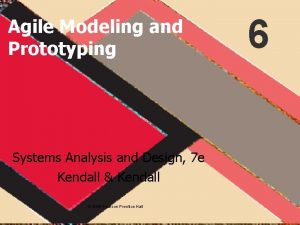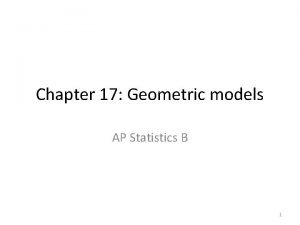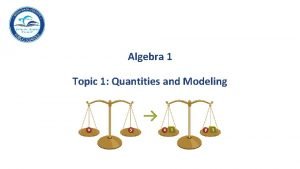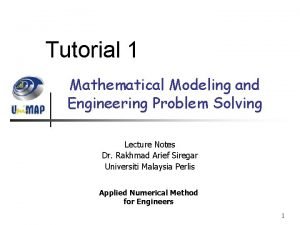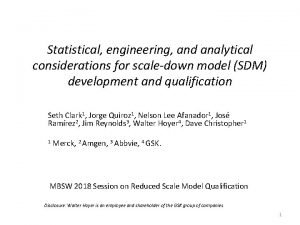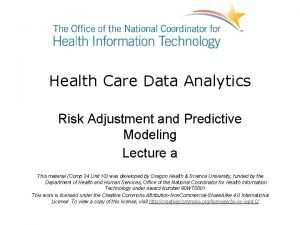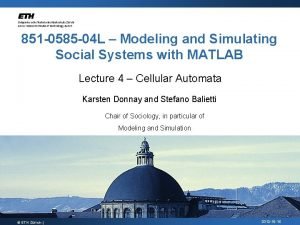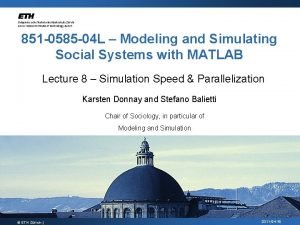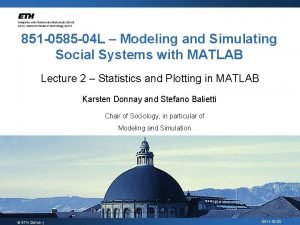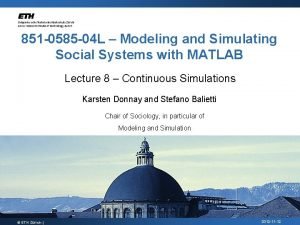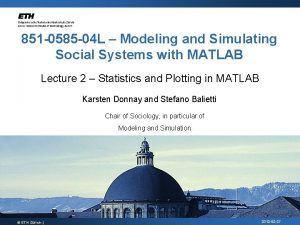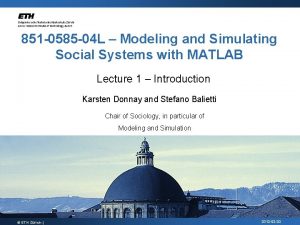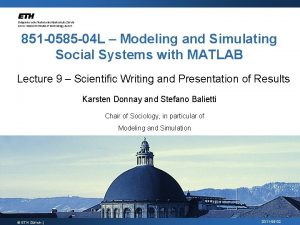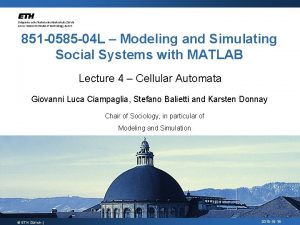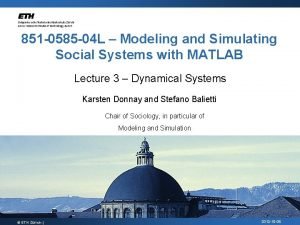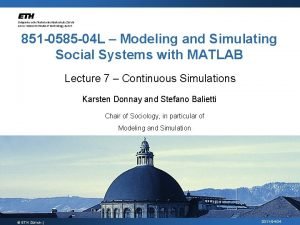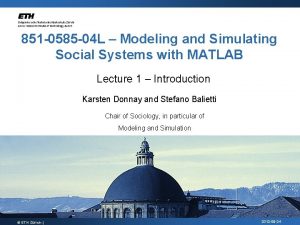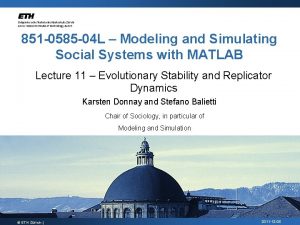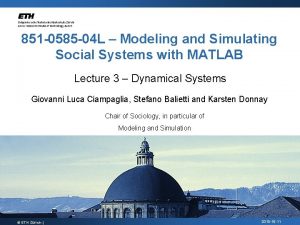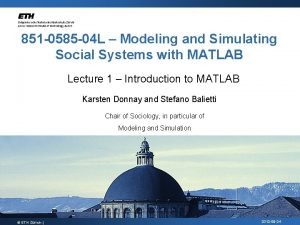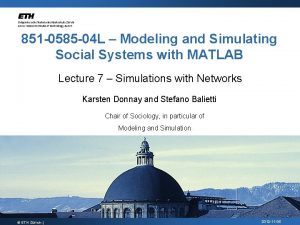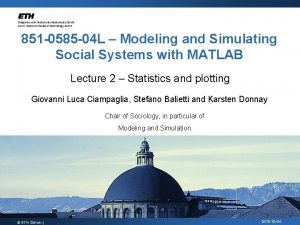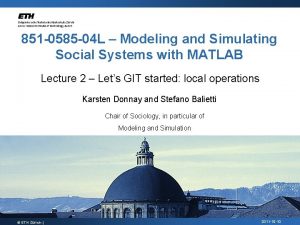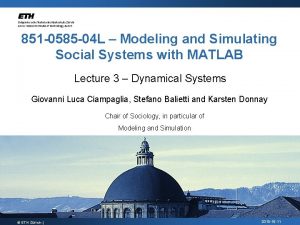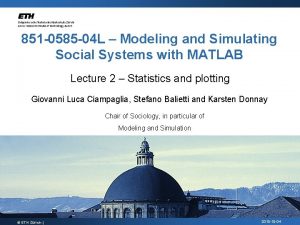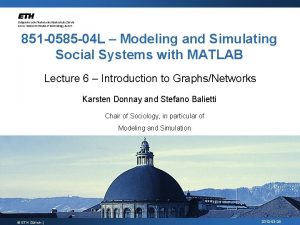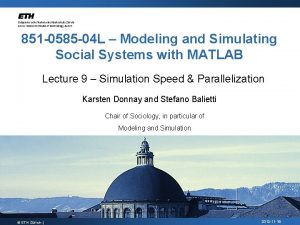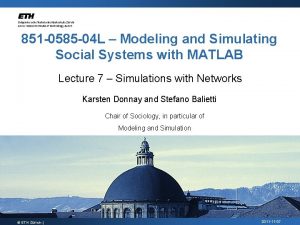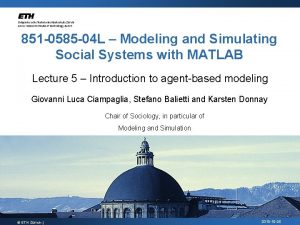851 0585 04 L Modeling and Simulating Social




















































- Slides: 52

851 -0585 -04 L – Modeling and Simulating Social Systems with MATLAB Lecture 3 – Dynamical Systems Karsten Donnay and Stefano Balietti Chair of Sociology, in particular of Modeling and Simulation © ETH Zürich | 2011 -03 -07

Schedule of the course Introduction to MATLAB 21. 02. 28. 02. 07. 03. 14. 03. 21. 03. 28. 03. Working on projects (seminar theses) 04. 18. 04. 02. 05. 09. 05. 16. 05. 23. 05. 30. 05. 2011 -03 -07 Introduction to social-science modeling and simulation Handing in seminar thesis and giving a presentation (final deadlines to be communicated) K. Donnay & S. Balietti / kdonnay@ethz. ch sbalietti@ethz. ch 2

Schedule of the course Introduction to MATLAB 21. 02. 28. 02. 07. 03. 14. 03. 21. 03. 28. 03. Working on projects (seminar theses) 04. 18. 04. Introduction to social-science modeling and simulation 02. 05. 09. 05. 16. 05. 23. 05. 30. 05. 2011 -03 -07 Create and Submit a Research Plan Handing in seminar thesis and giving a presentation (final deadlines to be communicated) K. Donnay & S. Balietti / kdonnay@ethz. ch sbalietti@ethz. ch 3

Goals of Lecture 3: students will 1. Consolidate knowledge acquired during lecture 2, through brief repetition of the main points and revision of the exercises. 2. Understand fully the importance and the role of a Research Plan and its main standard components. 3. Learn the basic definition of Dynamical Systems and Differential Equations. 4. Implement Dynamical System in MATLAB a series of examples from Physics and Social Science Literature (Pendulum, Lorenz attractor, Lotka-Volterra equations, Epidemics: Kermack-Mc. Kendrick model) 2011 -03 -07 K. Donnay & S. Balietti / kdonnay@ethz. ch sbalietti@ethz. ch 4

Repetition § § § plot(), loglog(), semilogy(), semilogx() § Log-scale plots reduce the complexity of some functional forms and fit well to draw large range of values § The amplitude of the sample matters! law of large numbers – LLN. (Ex. 1) § Outlier observations can significantly skew the distribution, e. g. mean != median. (Ex. 2) Cov() and corrcoef() can measure correlation among variables. (Ex. 3) § hist(), sort() subplot() vs figure() 2011 -03 -07 K. Donnay & S. Balietti / kdonnay@ethz. ch sbalietti@ethz. ch 5

Repetition – Ex. 4 >> loglog(germany(: , 2), 'Line. Width', 3); 2011 -03 -07 K. Donnay & S. Balietti / kdonnay@ethz. ch sbalietti@ethz. ch 6

Project § Implementation of a model from the Social Science literature in MATLAB § During the next two weeks: § § § 2011 -03 -07 Form a group of two or three persons Choose a topic among the project suggestions (available on line) or propose your own idea Fill in the Research Plan (available on line) and send it to sbalietti@ethz. ch AND kdonnay@ethz. ch by email Subject line: [MATLAB FS 11] name 1, name 2, name 3 E. g. [MATLAB FS 11] donnay, balietti K. Donnay & S. Balietti / kdonnay@ethz. ch sbalietti@ethz. ch 7

Research Plan Structure § 1 -2 (not more!) pages stating: § Brief, general introduction to the problem § Fundamental questions you want to try to answer § Existing literature you will base your model on and possible extensions § Research methods you are planning to use § Use a Word/Openoffice format, to easily track changes § It will become the first page of your report. 2011 -03 -07 K. Donnay & S. Balietti / kdonnay@ethz. ch sbalietti@ethz. ch 8

Research Plan § Upon submission, the Research Plan can: be accepted § be accepted under revision § be modified later on only if change is justified (create new version) § § Talk to us if you are not sure § Remember: the sooner the better! § Final deadline for signing-up for a project is: March 14 th 2011 -03 -07 K. Donnay & S. Balietti / kdonnay@ethz. ch sbalietti@ethz. ch 9

“Plans are useless, but planning is everything. ” Dwight David Eisenhower (14 Oct 1890 – 28 Mar 1969) 2011 -03 -07 K. Donnay & S. Balietti / kdonnay@ethz. ch sbalietti@ethz. ch 10

Dynamical systems § Mathematical description of the time dependence of variables that characterize a given problem/scenario in its state space. 2011 -03 -07 K. Donnay & S. Balietti / kdonnay@ethz. ch sbalietti@ethz. ch 11

Dynamical systems § A dynamical system is described by a set of linear/non-linear differential equations. § Even though an analytical treatment of dynamical systems is usually very complicated, obtaining a numerical solution is (often) straight forward. § Differential equation and Difference equation are two different tools for operating with Dynamical Systems 2011 -03 -07 K. Donnay & S. Balietti / kdonnay@ethz. ch sbalietti@ethz. ch 12

Differential Equations § A differential equation is a mathematical equation for an unknown function (dependent variable) of one or more (independent) explicative variables that relates the values of the function itself and its derivatives of various orders § Ordinary (ODE) : § Partial (PDE) : 2011 -03 -07 K. Donnay & S. Balietti / kdonnay@ethz. ch sbalietti@ethz. ch 13

Numerical Solutions for Differential Equations § Solving differential equations numerically can be done by a number of schemes. The easiest way is by the 1 st order Euler’s Method: x x(t) x(t-Δt) t Δt 2011 -03 -07 K. Donnay & S. Balietti / kdonnay@ethz. ch sbalietti@ethz. ch 14

A famous example: Pendulum § A pendulum is a simple dynamical system: L = length of pendulum (m) ϴ = angle of pendulum g = acceleration due to gravity (m/s 2) The motion is described by: 2011 -03 -07 K. Donnay & S. Balietti / kdonnay@ethz. ch sbalietti@ethz. ch 15

Pendulum: MATLAB code 2011 -03 -07 K. Donnay & S. Balietti / kdonnay@ethz. ch sbalietti@ethz. ch 16

Set time step 2011 -03 -07 K. Donnay & S. Balietti / kdonnay@ethz. ch sbalietti@ethz. ch 17

Set constants 2011 -03 -07 K. Donnay & S. Balietti / kdonnay@ethz. ch sbalietti@ethz. ch 18

Set starting point of pendulum 2011 -03 -07 K. Donnay & S. Balietti / kdonnay@ethz. ch sbalietti@ethz. ch 19

Time loop: Simulate the pendulum 2011 -03 -07 K. Donnay & S. Balietti / kdonnay@ethz. ch sbalietti@ethz. ch 20

Perform 1 st order Euler’s method 2011 -03 -07 K. Donnay & S. Balietti / kdonnay@ethz. ch sbalietti@ethz. ch 21

Plot pendulum 2011 -03 -07 K. Donnay & S. Balietti / kdonnay@ethz. ch sbalietti@ethz. ch 22

Set limits of window 2011 -03 -07 K. Donnay & S. Balietti / kdonnay@ethz. ch sbalietti@ethz. ch 23

Make a 10 ms pause 2011 -03 -07 K. Donnay & S. Balietti / kdonnay@ethz. ch sbalietti@ethz. ch 24

Pendulum: Executing MATLAB code 2011 -03 -07 K. Donnay & S. Balietti / kdonnay@ethz. ch sbalietti@ethz. ch 25

Lorenz attractor § The Lorenz attractor defines a 3 -dimensional trajectory by the differential equations: § σ, r, b are parameters. 2011 -03 -07 K. Donnay & S. Balietti / kdonnay@ethz. ch sbalietti@ethz. ch 26

Lorenz attractor: MATLAB code 2011 -03 -07 K. Donnay & S. Balietti / kdonnay@ethz. ch sbalietti@ethz. ch 27

Set time step 2011 -03 -07 K. Donnay & S. Balietti / kdonnay@ethz. ch sbalietti@ethz. ch 28

Set number of iterations 2011 -03 -07 K. Donnay & S. Balietti / kdonnay@ethz. ch sbalietti@ethz. ch 29

Set initial values 2011 -03 -07 K. Donnay & S. Balietti / kdonnay@ethz. ch sbalietti@ethz. ch 30

Set parameters 2011 -03 -07 K. Donnay & S. Balietti / kdonnay@ethz. ch sbalietti@ethz. ch 31

Solve the Lorenz-attractor equations 2011 -03 -07 K. Donnay & S. Balietti / kdonnay@ethz. ch sbalietti@ethz. ch 32

Compute gradient 2011 -03 -07 K. Donnay & S. Balietti / kdonnay@ethz. ch sbalietti@ethz. ch 33

Perform 1 st order Euler’s method 2011 -03 -07 K. Donnay & S. Balietti / kdonnay@ethz. ch sbalietti@ethz. ch 34

Update time 2011 -03 -07 K. Donnay & S. Balietti / kdonnay@ethz. ch sbalietti@ethz. ch 35

Plot the results 2011 -03 -07 K. Donnay & S. Balietti / kdonnay@ethz. ch sbalietti@ethz. ch 36

Animation 2011 -03 -07 K. Donnay & S. Balietti / kdonnay@ethz. ch sbalietti@ethz. ch 37

2011 -03 -07 K. Donnay & S. Balietti / kdonnay@ethz. ch sbalietti@ethz. ch 38

Food chain 2011 -03 -07 K. Donnay & S. Balietti / kdonnay@ethz. ch sbalietti@ethz. ch 39

Lotka-Volterra equations § The Lotka-Volterra equations describe the interaction between two species, prey vs. predators, e. g. rabbits vs. foxes. x: number of prey y: number of predators α, β, γ, δ: parameters 2011 -03 -07 K. Donnay & S. Balietti / kdonnay@ethz. ch sbalietti@ethz. ch 40

Lotka-Volterra equations § The Lotka-Volterra equations describe the interaction between two species, prey vs. predators, e. g. rabbits vs. foxes. 2011 -03 -07 K. Donnay & S. Balietti / kdonnay@ethz. ch sbalietti@ethz. ch 41

Lotka-Volterra equations § The Lotka-Volterra equations describe the interaction between two species, prey vs. predators, e. g. rabbits vs. foxes. 2011 -03 -07 K. Donnay & S. Balietti / kdonnay@ethz. ch sbalietti@ethz. ch 42

Epidemics Source: Balcan, et al. 2009 2011 -03 -07 K. Donnay & S. Balietti / kdonnay@ethz. ch sbalietti@ethz. ch 43

SIR model § A general model for epidemics is the SIR model, which describes the interaction between Susceptible, Infected and Removed (immune) persons, for a given disease. 2011 -03 -07 K. Donnay & S. Balietti / kdonnay@ethz. ch sbalietti@ethz. ch 44

Kermack-Mc. Kendrick model § Spread of diseases like the plague and cholera? A popular SIR model is the Kermack-Mc. Kendrick model. § The model assumes: A constant population size. § A zero incubation period. § The duration of infectivity is as long as the duration of the clinical disease. § 2011 -03 -07 K. Donnay & S. Balietti / kdonnay@ethz. ch sbalietti@ethz. ch 45

Kermack-Mc. Kendrick model § The Kermack-Mc. Kendrick model is specified as: S: Susceptible persons I: Infected persons R: Removed (immune) persons β: Infection rate γ: Immunity rate 2011 -03 -07 S β transmission R γ recovery K. Donnay & S. Balietti / kdonnay@ethz. ch sbalietti@ethz. ch I 46

Kermack-Mc. Kendrick model § The Kermack-Mc. Kendrick model is specified as: S: Susceptible persons I: Infected persons R: Removed (immune) persons β: Infection rate γ: Immunity rate 2011 -03 -07 K. Donnay & S. Balietti / kdonnay@ethz. ch sbalietti@ethz. ch 47

Kermack-Mc. Kendrick model § The Kermack-Mc. Kendrick model is specified as: S: Susceptible persons I: Infected persons R: Removed (immune) persons β: Infection rate γ: Immunity rate 2011 -03 -07 K. Donnay & S. Balietti / kdonnay@ethz. ch sbalietti@ethz. ch 48

Exercise 1 § Implement and simulate the Kermack. Mc. Kendrick model in MATLAB. Use the starting values: S=I=500, R=0, β=0. 0001, γ =0. 01 2011 -03 -07 K. Donnay & S. Balietti / kdonnay@ethz. ch sbalietti@ethz. ch 49

Exercise 2 § A key parameter for the Kermack-Mc. Kendrick model is the epidemiological threshold, βS/γ. Plot the time evolution of the model and investigate the influence of the epidemiological threshold, in particular the cases: 1. 2. βS/γ < 1 βS/γ > 1 Starting values: S=I=500, R=0, β=0. 0001 2011 -03 -07 K. Donnay & S. Balietti / kdonnay@ethz. ch sbalietti@ethz. ch 50

Exercise 3 - optional § Implement the Lotka-Volterra model and investigate the influence of the timestep, dt. § How small must the timestep be in order for the 1 st order Euler‘s method to give reasonable accuracy? § Check in the MATLAB help how the functions ode 23, ode 45 etc, can be used for solving differential equations. 2011 -03 -07 K. Donnay & S. Balietti / kdonnay@ethz. ch sbalietti@ethz. ch 51

References § Matlab and Art: http: //vlab. ethz. ch/ROM/DBGT/MATLAB_and_art. html § Kermack, W. O. and Mc. Kendrick, A. G. "A Contribution to the Mathematical Theory of Epidemics. " Proc. Roy. Soc. Lond. A 115, 700 -721, 1927. § "Lotka-Volterra Equations”. http: //mathworld. wolfram. com/Lotka. Volterra. Equations. html § § http: //en. wikipedia. org/wiki/Numerical_ordinary_differential_equations "Lorenz Attractor”. http: //mathworld. wolfram. com/Lorenz. Attractor. html 2011 -03 -07 K. Donnay & S. Balietti / kdonnay@ethz. ch sbalietti@ethz. ch 52
 Cadaveric spasm and rigor mortis difference
Cadaveric spasm and rigor mortis difference Postmortem signs
Postmortem signs Helen c. erickson
Helen c. erickson 10 cfr 851
10 cfr 851 Regulation 851
Regulation 851 851
851 Relational modeling vs dimensional modeling
Relational modeling vs dimensional modeling National general 888-781-0585
National general 888-781-0585 Ngic 888-781-0585
Ngic 888-781-0585 Social thinking social influence social relations
Social thinking social influence social relations Social thinking social influence social relations
Social thinking social influence social relations Spontaneous generation in data flow diagram
Spontaneous generation in data flow diagram Modeling with quadratic functions
Modeling with quadratic functions Typical process description tools include
Typical process description tools include Social darwinism vs social gospel answer key
Social darwinism vs social gospel answer key Simulation kelton
Simulation kelton Sequential decision analytics
Sequential decision analytics Log to exponential form
Log to exponential form Dfd chapter 5
Dfd chapter 5 System requirements checklist output example
System requirements checklist output example Business process and functional modeling
Business process and functional modeling Business process and functional modeling
Business process and functional modeling Modeling and imitation training aba
Modeling and imitation training aba Modeling and imitation
Modeling and imitation Algebra 1 bootcamp functions and modeling
Algebra 1 bootcamp functions and modeling Algebra bootcamp answers
Algebra bootcamp answers Algebra bootcamp answers
Algebra bootcamp answers Patched-up prototype
Patched-up prototype Additive and subtractive modeling
Additive and subtractive modeling Agile modeling and prototyping
Agile modeling and prototyping 2019 algebra 1 bootcamp answers
2019 algebra 1 bootcamp answers Algebra bootcamp answers
Algebra bootcamp answers Object oriented modeling and design books
Object oriented modeling and design books Pharmaceutical simulation and modeling
Pharmaceutical simulation and modeling Introduction to modeling and simulation
Introduction to modeling and simulation Jeff renz
Jeff renz Mathematical modeling and engineering problem solving
Mathematical modeling and engineering problem solving Biomedical modeling and simulation
Biomedical modeling and simulation Device modeling for analog and rf cmos circuit design
Device modeling for analog and rf cmos circuit design Patched-up prototype
Patched-up prototype Subtractive modeling definition
Subtractive modeling definition Introduction to modeling and simulation
Introduction to modeling and simulation Computational engineering and physical modeling
Computational engineering and physical modeling Geometric modeling in probability and statistics
Geometric modeling in probability and statistics Addition property of equality
Addition property of equality Job analysis and competency modeling
Job analysis and competency modeling Merger and acquisition financial modeling
Merger and acquisition financial modeling Softwares can_ -in designing and modeling in every field
Softwares can_ -in designing and modeling in every field Mathematical modeling and engineering problem solving
Mathematical modeling and engineering problem solving Modeling and simulation
Modeling and simulation Image-based modeling and rendering
Image-based modeling and rendering Open venation
Open venation Health care risk adjustment and predictive modeling
Health care risk adjustment and predictive modeling

